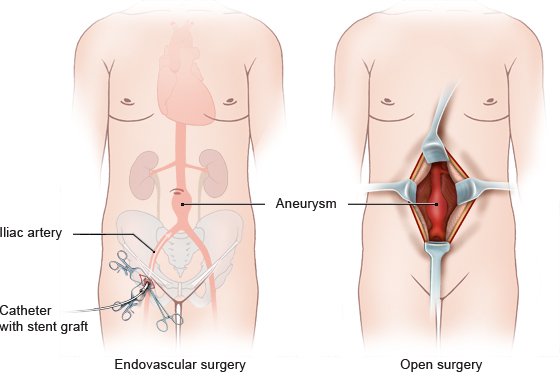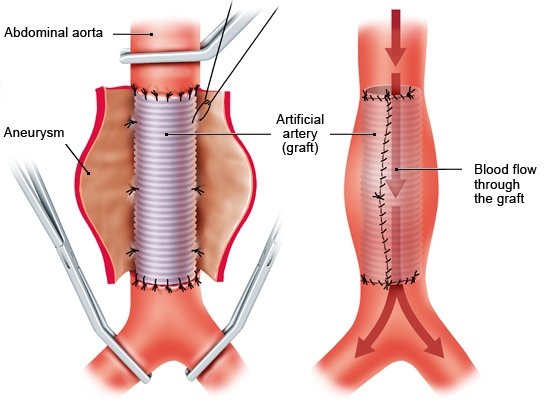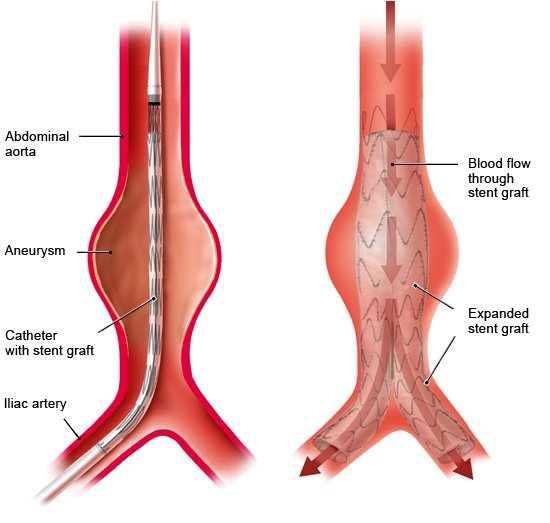Antoniou GA, Antoniou SA, Torella F. Editor's Choice - Endovascular vs. Open Repair for Abdominal Aortic Aneurysm: Systematic Review and Meta-analysis of Updated Peri-operative and Long Term Data of Randomised Controlled Trials. Eur J Vasc Endovasc Surg 2020; 59(3): 385-397.
Behrendt CA, Heckenkamp J, Cotta L et al. Versorgung des Bauchaortenaneurysmas in Deutschland: Ein Bericht des Qualitätsregisters der DGG im Jahr 2023. Gefäßchirurgie 2024; 29(5): 301-308.
Deutsche Gesellschaft für Gefäßchirurgie und Gefäßmedizin - Gesellschaft für operative, endovaskuläre und präventive Gefäßmedizin (DGG). S3-Leitlinie zu Screening, Diagnostik, Therapie und Nachsorge des Bauchaortenaneurysmas. AWMF-Registernr.: 004-014l (in Überarbeitung). 2023.
Epple J, Svidlova Y, Schmitz-Rixen T et al. Long-Term Outcome of Intact Abdominal Aortic Aneurysm After Endovascular or Open Repair. Vasc Endovascular Surg 2023; 57(8): 829-837.
Institute for Quality and Efficiency in Health Care (IQWiG, Germany). Information for health insurance fund members on ultrasound screening for abdominal aortic aneurysms – addendum to commission S13-04; Commission P16-01. 2016.
Kent KC. Clinical practice. Abdominal aortic aneurysms. N Engl J Med 2014; 371(22): 2101-2218.
Lancaster EM, Gologorsky R, Hull MM et al. The natural history of large abdominal aortic aneurysms in patients without timely repair. J Vasc Surg 2022; 75(1): 109-117.
Mazzolai L, Teixido-Tura G, Lanzi S et al. 2024 ESC Guidelines for the management of peripheral arterial and aortic diseases. Eur Heart J 2024; 45(36): 3538-3700.
National Institute for Health and Care Excellence (NICE). Abdominal aortic aneurysm: diagnosis and management (NICE Guidelines; No. NG156). 2020.
Paravastu SC, Jayarajasingam R, Cottam R et al. Endovascular repair of abdominal aortic aneurysm. Cochrane Database Syst Rev 2014; (1): CD004178.
Parkinson F, Ferguson S, Lewis P et al. Rupture rates of untreated large abdominal aortic aneurysms in patients unfit for elective repair. J Vasc Surg 2015; 61(6): 1606-1612.
Schmitz-Rixen T, Löffler A-K, Steinbauer M, Grundmann RT. Versorgung des intakten abdominellen Aortenaneurysmas (AAA) 2020/2021. Registerbericht des DIGG der DGG. 2023.
Sweeting MJ, Patel R, Powell JT, Greenhalgh RM. Endovascular Repair of Abdominal Aortic Aneurysm in Patients Physically Ineligible for Open Repair: Very Long-term Follow-up in the EVAR-2 Randomized Controlled Trial. Ann Surg 2017; 266(5): 713-719.
Wanhainen A, Van Herzeele I, Bastos Goncalves F et al. Editor's Choice - European Society for Vascular Surgery (ESVS) 2024 Clinical Practice Guidelines on the Management of Abdominal Aorto-Iliac Artery Aneurysms. Eur J Vasc Endovasc Surg 2024; 67(2): 192-331.
Wanhainen A, Verzini F, Van Herzeele I et al. Editor's Choice - European Society for Vascular Surgery (ESVS) 2019 Clinical Practice Guidelines on the Management of Abdominal Aorto-iliac Artery Aneurysms. Eur J Vasc Endovasc Surg 2019; 57(1): 8-93.
IQWiG health information is written with the aim of helping people understand the advantages and disadvantages of the main treatment options and health care services.
Because IQWiG is a German institute, some of the information provided here is specific to the German health care system. The suitability of any of the described options in an individual case can be determined by talking to a doctor. informedhealth.org can provide support for talks with doctors and other medical professionals, but cannot replace them. We do not offer individual consultations.
Our information is based on the results of good-quality studies. It is written by a team of health care professionals, scientists and editors, and reviewed by external experts. You can find a detailed description of how our health information is produced and updated in our methods.




